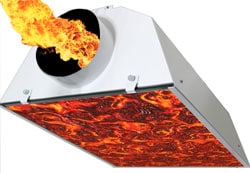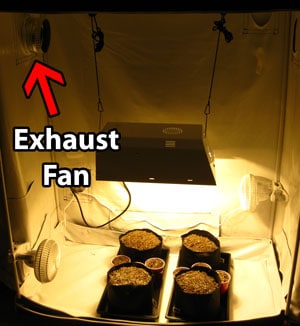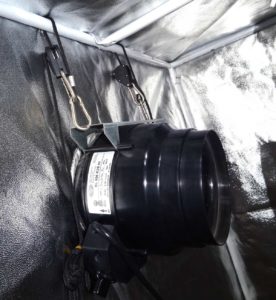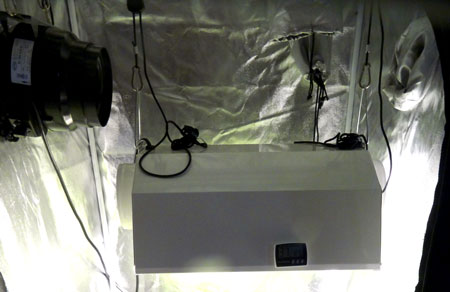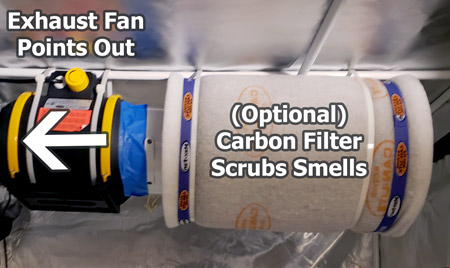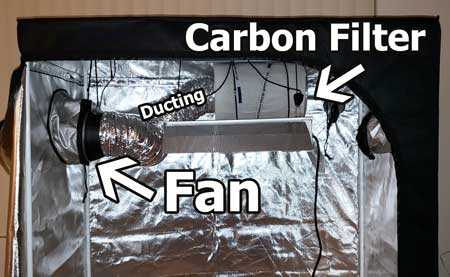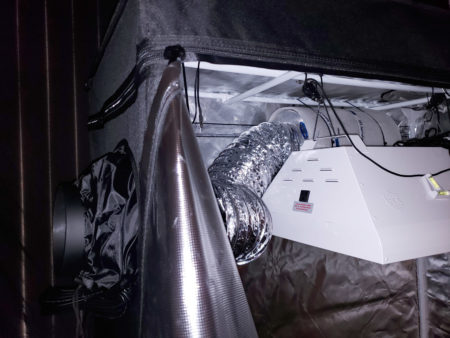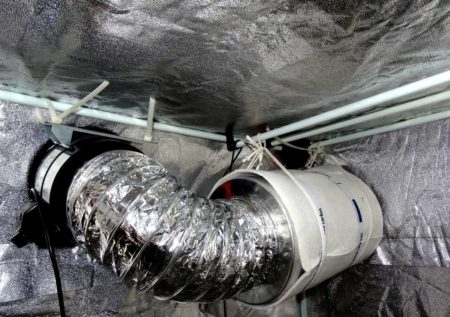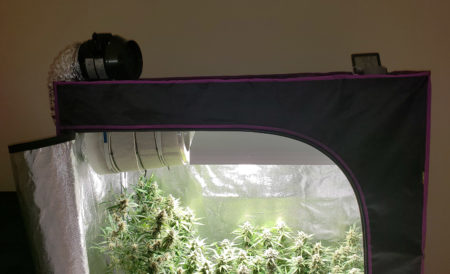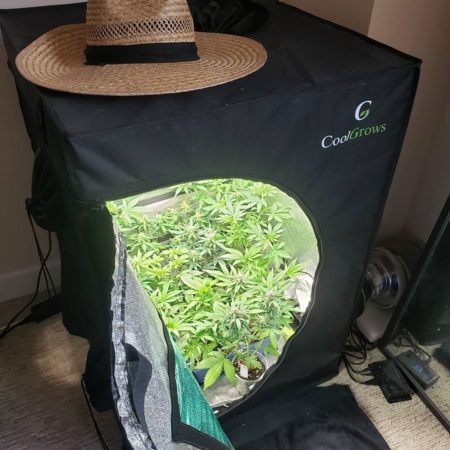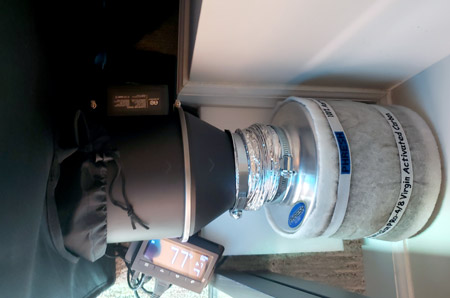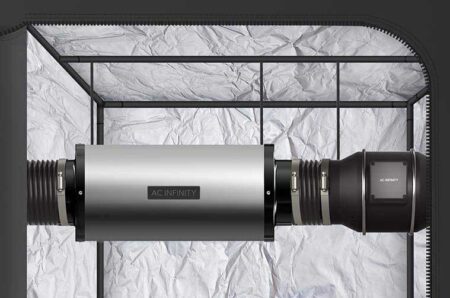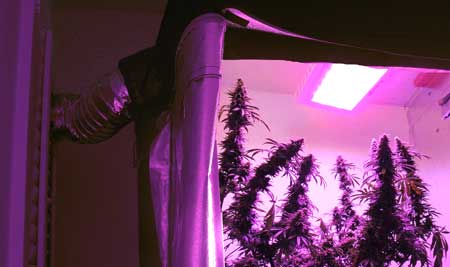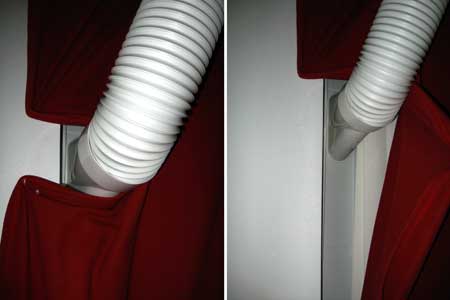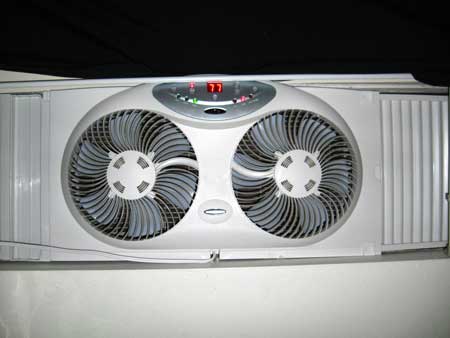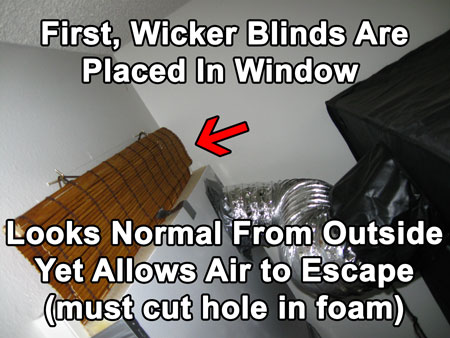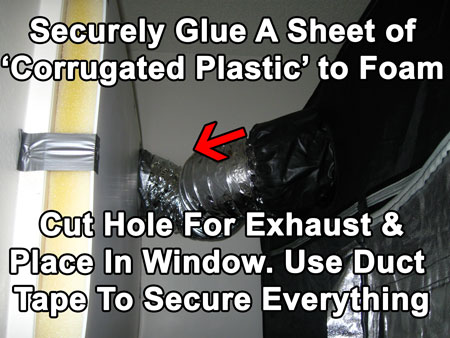by Nebula Haze
Indoor cannabis grow lights can get hot, even lights that run relatively cool like LEDs. For most cannabis growers, venting hot air out of the grow space with fans is a great way to control heat that saves a ton of money over using an AC.
Cannabis grow lights can get hot. This tutorial will show you how to vent heat from the grow space using fans to save a ton of money on electricity compared to running an AC.
How To Set Up Your Cannabis Exhaust to Vent Heat
Optimally, you want to pull air from your hot lights and directly out a window, in a short, straight line if possible. This is typically done using a strong exhaust fan coupled with ducting for greater effectiveness. Exhausts become less and less efficient at cooling the further your air has to travel, and the less straight the path. A short, straight, direct line to a window is the best-case scenario when it comes to setting up your exhaust.
Bonus: Setting up an exhaust makes it easy to filter smells as the air leaves the grow space by hooking up the exhaust fan to a carbon filter.
LED Grow Lights (and Naked Bulbs)
When growing with LED grow lights (or any grow light that is “naked” to the air like a bulb grow light with a basic reflector), your goal is simply to vent heat out of the grow tent or grow space. There’s no way to “connect” your fan to your grow light. This is a less efficient way of venting heat, but much easier and usually more-than-effective-enough if you’re using good LED grow lights which tend to run cool.
How to vent heat from LEDs and big bulb lights:
- Set up a good exhaust fan to vent heat out of the grow space
- This works best when using a grow tent since you just put an exhaust fan in a vent pointing out and you’re done
- (optional) Connect the exhaust fan to a carbon filter and you will filter cannabis odors so no one can smell your grow
Use an exhaust fan to vent hot air out of your grow space.
With a grow tent this is easy. Just hang your exhaust fan in a vent, pointing out.
This pulls out all the heat produced by the grow light, while also bringing fresh cool air into the tent from vents at the bottom.
Warning: If you vent heat directly into the room, it will raise the temperature of the room by several degrees!
If you connect the fan with a carbon filter (some examples below), not only will you vent out heat but also “scrub” all odors from the air before it leaves the tent.
A carbon filter connected to a fan pointing out of the tent will filter out all smells so no one in the room can smell your plants.
There are multiple configurations with a carbon filter and fan that work. Most commonly, the carbon filter is inside the tent with the fan in a vent.
Although a straight line with the fan and carbon filter directly connected is the most efficient, ducting is often used to position the carbon filter to the side so the grow light can be moved up to the top of the tent.
Here’s another way to position the carbon filter so it doesn’t get in the way of the grow light
If there isn’t enough room in the tent even with ducting, you can have the carbon filter inside and the exhaust fan outside
Or the exhaust fan outside and fan in the vent. This is much less efficient (carbon filter is best if used inside) but does work 80% as well and may be necessary to save space in the tent. For example, this mini tent has no room inside. So I put the fan in a port near the bottom right and placed the carbon filter outside on the floor.
When growing in a mini tent, sometimes you need to get creative with the exhaust to get it to fit. I placed this exhaust fan and carbon filter on the lower right.
This isn’t ideal (it’s best for the carbon filter to be inside and fan located at the top of the tent) but for small grows this can be a lot easier, and is effective enough to get the job done. Here’s what that looked like from the outside.
How to reduce noise / sound from an exhaust fan
How can you reduce sound from fans as much as possible when venting? A stealthy cannabis garden should be as quiet as possible.
- Invest in a quiet exhaust fan – Quiet exhaust fans are much more expensive than loud exhaust fans, but if sound is a concern the investment is worth it. The quietest exhaust fans I’ve used are the ones by AC Infinity.
- Use insulated ducting – Insulated ducting is thicker and helps reduce sound compared to regular ducting. This not only helps with sound but prevents any tears long-term, which is important to maintain your exhaust system’s efficiency.
- Muffler / duct silencer – An inline duct silencer specialized piece of equipment meant to help reduce sounds. Make sure to get one that fits your fan, and that you have room to install it in your space (they’re surprisingly big).
- Hang the fan (don’t set it on something) – A tent that is strapped directly to a bar, or sitting on top of something, tends to be louder than one that’s hanging from the top of the tent with rope ratchets. Hanging from ropes helps greatly reduce vibration and therefore noise.
- Keep fan inside the tent – Sometimes you have to keep the fan outside the tent due to space concerns. However, if possible, keeping the fan inside the tent tends to be much quieter than if the fan is located outside (especially sitting on top of the tent).
Notice how this exhaust fan is being hung from rope ratchets. Hanging the fan tends to be quieter than if you set it on something.
Connect your exhaust fan to a muffler along with insulated ducting to reduce the noise further.
How to vent heat from the room
- If you vent heat into the room, it will raise the temperature by several degrees
- To get the hat out of the room, connect the exhaust fan to a window with ducting. This pushes hot air directly outside before it ever touches your room (the most effective way to keep a room cool)
- If that’s not possible, use a window fan to vent heat out (not as efficient but works in a pinch)
Here’s one of those in action
Typically the exhaust is set up so that people from outside can’t see anything unusual is going on in the room. For example, I used a portable AC Window Seal Kit with ducting attached to a fan for this stealthy exhaust. Essentially, this is how a portable AC is set up to vent heat discreetly out a window, only I attached it to the exhaust fan instead.
Learn one idea to set up a stealthy window exhaust at the bottom of the article!
Window Fan
Can’t connect anything to your window or don’t want to use ducting? There are still options to help vent heat out of the grow room to the outside. For example, a window fan can pull out a lot of heat even if it’s not directly connected to your grow tent.
A window fan isn’t nearly as good as venting directly out a window but can help remove heat if you can’t connect ducting to your window for whatever reason
Air-cooled hoods
You get the best results with an “air-cooled hood” (the grow light is completely enclosed within the reflector) by connecting the grow light directly to the ducting.
Use ducting and a strong fan to pull air directly from your air-cooled hood and out your exhaust.
When worried about heat, it’s important to create enough suction with your fans to completely replace all the air in your grow tent as rapidly as possible, at least once every few minutes. Even when you’re not worried about heat, it’s still important to regularly replace the air and make sure there’s plenty of airflow and circulation above and below your plants.
Here are a few guidelines that will help you achieve the best exhaust system possible:
- It’s important to have a strong-enough exhaust fan for the grow space to make sure that you are completely changing out all the air in the tent often.
- Designing your exhaust will be much simpler if you take the time to understand airflow in a room – the whole idea of setting up an exhaust system is to create negative airflow in the grow space or grow tent so that any hot air is regularly replaced with new, fresh cool air.
- All the air in the tent should be replaced by new air every 1-3 minutes for the best results. You can calculate the strength of the exhaust fan you need based on the dimensions of your grow space. Learn how to calculate the type of fan you need below…
- When your grow tent is bending in from the exhaust fan, it means you’ve got good suction going in there and have created negative airflow
- Make sure your intake hole is bigger than your exhaust hole to achieve proper suction – in other words, the holes/spaces for new air to come in (vents, intake fans, doors, windows) should be bigger than the hole/space where the air is being pulled out the tent by your exhaust fan
- Even with a good exhaust system, it is recommended that growers still install small fans in their grow space to blow air above and below to the plant canopy to improve air circulation and help prevent any hot spots or humid pockets of air
How to Calculate The Exhaust Fan Strength You Need
Most important – remember you want to completely replace all the air in your grow area at least once every few minutes. If you’re worried about heat, exchange all the air every 1 minute. If it’s cooler where you live, then exchange all the air about once every 3 minutes.
Here’s how to determine what fan you need for your space
- Determine the cubic area of your space by multiplying Length x Width x Height.
Example: for a 4’x4’x7′ grow tent, 4x4x7 = 161 cubic feet. - Choose how often you want to exchange your air. Once every 1 minute for a hot space, once every 2 minutes for areas with moderate climates, and once every 3 minutes for a cooler locale.
Example: For areas with moderate (medium) temperatures, I want to exchange all the air in the tent once every 2 minutes, so my answer is “2”. - Determine how much cubic feet/minute of air you need to move by dividing your number from step 1 by your number from step 2
Example: 161 / 2 = 80.5 (that’s how many cubic feet/minute I need the exhaust fan to move) - Pick your fan. Fans are measured by CFM (cubic feet/minute), so you need a fan that has a CFM higher than the number you figured out in Step 3.
Example: I would need a fan rated at least 80.5 CFM or more if I wanted it to exchange all the air every 2 minutes.
When in doubt, it’s always better to get a bigger fan than you need. You can always use a speed controller or put the fan on a timer if the fan is cooling your space too fast, or if you go through a cold spell.
Cannabis plants like having a lot of fresh air all the time, and they will reward you for your diligence in setting up a proper exhaust system.
Choose the Placement of Your Grow Tent & Exhaust Carefully
Consider that you want a direct line to the exhaust, with as short a distance as possible, so that hot air is quickly and easily released outside of your home.
Learn how to make a stealthy “secret window” exhaust system like this below…
Having trouble finding a cheap & easy way to stealthily exhaust out hot air from your grow tent? I used a combination of the following items to create an awesome exhaust system for about $45 (just add your fan).
What You Need
- wicker blinds
- foam
- corrugated plastic
- duct tape
- ducting
- super glue/hot glue
- staple gun
*All these items can be found at a home improvement store, as they are common items for upgrading around the house
First, hang the wicker blinds in your window like normal. Air can escape through these blinds, but you can’t see through them to the other side. They are commonly used in bedrooms and other windows that lead into private areas.
I bought a huge sheet of foam and glued it (super glue and hot glue for best results) to a sheet of corrugated plastic. You can buy both these items for a few bucks at a home improvement store like Home Depot.
Next, use some ducting to trace a round, duct-sized hole on the foam/plastic. Note: Cut out the duct-sized hole in the foam/corrugated plastic near the top of where it will be mounted. Remember, heat rises, so having the exhaust exit near the top is much more efficient.
Run the ducting through the hole you cut, and right up to the wicker blinds. The ducting should be butted up against the wicker blinds so that heat escapes directly outside (since it will be able to pass through the blinds easily). Use duct tape to hold the foam/plastic in place, then use more duct tape to hold the ducting in place. In the end, after everything is placed and you’re happy with how everything looks, you will use a staple gun to staple all your duct tape in place but don’t worry about that yet.
I also used duct tape to secure the foam to the window because it’s cheap, easy to use, and durable when combined with staples.
Use a staple gun to reinforce anywhere you use duct tape, including where the ducting goes through the hole you made in the foam.
I like using foam + corrugated plastic because it’s inexpensive and easy to cut the hole for the exhaust. Having the foam/plastic combo in the window increases the suction in the room so more hot air is vented out and blocks light (no light gets in or out). As an added bonus, the foam dramatically reduces the noise of the fan (so you can just barely hear it even when you’re standing right outside the window).
You now know everything I wish I’d known before I started growing with HID lights. If you’re serious about growing cannabis, HID grow lights are going to give you the best yields, the most ease of use, and (in my opinion) the most enjoyable growing experience.
Now that you know exactly how to get started…
It’s time to start growing! Here are some articles you may enjoy:

